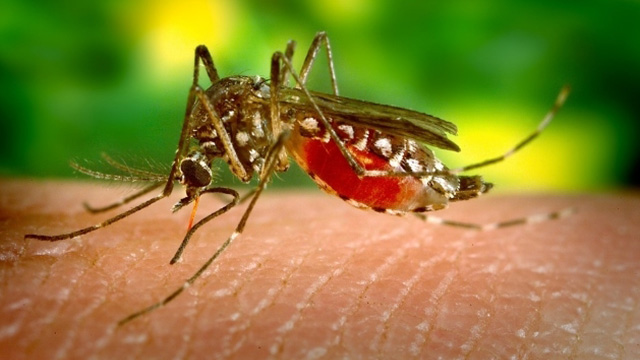Florida preparing to fight Zika with controversial insecticide linked to severe health and environmental effects
Friday, August 05, 2016 by: Julie Wilson staff writer
Tags: Zika hysteria, pesticide spraying, health effects

(NaturalNews) Let's face it, as was the case with Ebola, the media is blowing this Zika virus threat totally out of proportion, and as a result, some really bad decisions are being made along the way. As far as we've been told, the disease affects only a small portion of the population – pregnant women and those who may become pregnant in the near future.
The claim that Zika causes birth defects is based solely on "using epidemiological statistics, not rigorous scientific studies of cause and effect," wrote the Health Ranger in a hit piece exposing the outbreak as an engineered pandemic to justify chemical spraying.
Scientists' assertions are based on what they believe is a cause-and-effect relationship between the virus and developmental deformities in children born in regions of South America, home to mosquitoes carrying Zika.
But what researchers are failing to acknowledge, is that there are other, more likely causes of microcephaly, a severe birth defect resulting in reduced head size. Various types of pesticides are also known to cause birth defects.
Health officials are intent on spraying deadly chemicals into the air
Unfortunately, health officials have a one-track mind when it comes to fighting Zika – and that involves the administration of more harmful chemicals, regardless of the adverse health and environmental effects.Reports confirm that Florida (where non-travel related cases of Zika were discovered) intends to begin aerial spraying of a densely populated urban area with a dangerous insecticide called "naled."
The chemical assault or "campaign" as the mainstream media describes it will cover a 10-mile area including the one-mile-square area just north of downtown Miami, which experts have identified as a "hub" for Zika transmission.
The U.S. Centers for Disease Control and Prevention in conjunction with the Florida Health Department recommended the aerial spraying to reduce adult mosquito populations capable of spreading the virus.
CDC Director Dr. Thomas Frieden said in a recent conference call that he's concerned "that vector control efforts so far" have not been very effective – likely because the insects have grown resistant to commonly used insecticides – prompting officials to turn to the new chemical, naled.
New insecticide to be aerially sprayed can cause paralysis when inhaled
Naled is an organophosphate insecticide that when it breaks down in animals and the environment, causes "many health effects, both chronic and acute," according to Toxipedia.org, adding that it acts as a "severe" irritant to the skin and eyes.The chemical can affect animal and human health through ingestion and inhalation, the latter of which is believed to cause the most damage. Animal studies showed naled to be 20 times more toxic to rats when it was inhaled versus consuming the chemical in food and water.
This is highly concerning considering health officials plan to dispense the insecticide through aerial spraying, placing people at risk for inhaling the toxicant.
Pesticide drift makes this route of exposure even more likely. Researchers at the University of Florida found aerially sprayed naled may travel up to 750 meters away from the initial application site.
Animal studies show that naled exposure causes "chronic nervous system damage resulting in a mineralization of the spinal cord and decreased nervous system enzyme activity that led to partial paralysis."
The insecticide is also harmful to aquatic life, important insects such as pollinators, and in general is "very toxic to most organisms."
'Environmental terrorism'
Proposals to deploy naled in other countries to combat Zika have drawn immense controversy. The Puerto Rican government met intense backlash from anti-fumigation activists when it announced plans to begin aerial spraying of the chemical.The opposition was so strong that officials eventually agreed to suspend its use. San Juan Mayor Carmen Yulin Cruz said that spraying naled into the air is a form of "environmental terrorism."
Doctors, farmers and activists expressed grave concerns about the chemical's health and environmental effects, including its ability to kill honeybees, whose populations are already in sharp decline.
America's decision to deploy such a deadly chemical to fight a disease that may or may not be causing birth defects is completely irrational and borderline insane. There's a very good chance it could cause more birth defects, as well as other irreparable conditions.
The CDC states on its website that most people who contract Zika do not have any symptoms, and when they do, they are typically mild and include things like joint and muscle pain, headaches and fever.
"People usually don't get sick enough to go to the hospital, and they very rarely die of Zika," the CDC says. "Once a person has been infected with Zika, they are likely to be protected from future infections."
Sources:
NaturalNews.com
NaturalNews.com
CDC.gov
TeleSurTV.net
Toxipedia.org
CA.News.Yahoo.com (Reuters)
CBSNews.com
Zika hysteria at FETCH.news
Get independent news alerts on natural cures, food lab tests, cannabis medicine, science, robotics, drones, privacy and more.
Take Action: Support Natural News by linking to this article from your website
Permalink to this article:
Embed article link: (copy HTML code below):
Reprinting this article:
Non-commercial use OK, cite NaturalNews.com with clickable link.
Follow Natural News on Facebook, Twitter, Google Plus, and Pinterest
- Newly released JFK files reveal Pentagon's role in creating Lyme disease and covid in the same lab
- The hidden dangers in your kitchen: How cooking methods impact diabetes, cancer and aging
- DEADLY DECEPTION: How COVID vaccines increased mortality rates and why authorities hid the truth
- CDC finally halts $11 billion COVID funding scam as health officials admit the ‘pandemic’ was a fraud
- Arkansas embraces medical freedom with landmark ivermectin law
- GAIN-OF-FUNCTION CAT-BIRD-FLU now on the rise as nearly a dozen cats in Colorado "test positive" for Bird Flu due to contaminated cat food
- Lab leak confirmed? Boris Johnson's stunning reversal on COVID origins sparks global debate
- Home gardening for preppers: A beginner's guide to growing your own food
- Trump's greatest betrayal so far: Accelerating Middle East wars, silencing dissent, and serving Zionist masters
- Why you should think twice before buying mainstream toothpaste formulas
- Cartels shift tactics: Kidnappings and organ trafficking surge as border crossings plummet under Trump policies
- Was JFK's assassination orchestrated by a CIA double agent? New evidence points to James Angleton as the “architect”
- ATTENTION PRESIDENT TRUMP: Please WITHDRAW your nomination of Dr. Susan Monarez for CDC Director as she is a VAX FANATIC and TOXIC JAB ZEALOT
- Here are TEN all-natural ways to protect your garden without using harmful chemicals
- Key nodes of Federal Government censorship
- Record honeybee deaths devastate U.S. agriculture, pesticides under scrutiny
- Speaker Johnson warns Congress may defund or disband rogue courts targeting Trump
- Paper or plastic? The environmental deception behind bag bans
- Newly released JFK files reveal Pentagon's role in creating Lyme disease and covid in the same lab
- Elon Musk: Aliens could be here on Earth RIGHT NOW
- Festive flavors: The sweet history, nutritional profile and health benefits of pecan pie
- Trump reverses course on Gaza plan, says “nobody is expelling Palestinians”
- Reclaim your health: How midlife exercise reverses years of inactivity
- Big Pharma's $8 Billion bribery scheme exposed: how doctors are pushed to prescribe junk science, not heal
- Boys are back in town: Trump’s patriotic alpha crew takes the wheel while toxic females ride in the backseat
- EPA advisor admits the agency is funneling billions to climate groups ahead of Trump’s return to White House
- Space war brewing? Russia threatens to destroy Starlink satellites
- Survival 101: Effective EMF blocking techniques
- A lack of integrity in Academia: Harvard professor found GUILTY of fraudulent research to promote CRT theory
- Mike Adams Sermon 66: God will DESTROY ISRAEL for its wickedness
- 5 Simple steps to boost your brainpower: How to strengthen executive function in a distracted world
- Rep. Nancy Mace introduces bill to ban biological males from female facilities on federal property
- Sugarcane extract superior to cholesterol-lowering drugs?
- WHO focusing more on policing speech about public health and implementing global surveillance systems
- Pilots report mysterious lights 'moving at extreme speeds' across Oregon skies
- Dr. Mike Yeadon releases 15-minute testimony - WATCH - about genocidal intent of COVID “vaccines”
- EPA advisor admits the agency is funneling billions to climate groups ahead of Trump’s return to White House
- The Health Ranger releases “Vaccine Zombie” song and music video, using AI-animated zombies for the music video
- California's social media censorship law struck down: A victory for free speech or a threat to online safety?
- Dr. Mike Yeadon releases 15-minute testimony - WATCH - about genocidal intent of COVID “vaccines”
- The pandemic as a tool for INDOCTRINATION: Understanding “The Indoctrinated Brain” by Dr. Michael Nehls
- Florida takes a stand: DeSantis proposes permanent ban on mRNA vaccine mandates
- Mike Adams releases country western hit single: Goin’ Back in Time is Comin’ Home
- Mike Adams releases music poetry sensation: A Child of God
- “Why we influenced the 2020 elections”: Facebook files reveal the coordinated effort to bury the Hunter Biden laptop story
- RFK Jr. clears key hurdle: Sen. Susan Collins backs controversial HHS nominee, signaling a new era for health policy
- Unpacking the Lies That We’ve Been Fed – new song and music video released by Mike Adams, the Health Ranger
- Mike Adams releases new song and music video: Nothing More Disgusting Than a Globalist
- Newly released JFK files reveal Pentagon's role in creating Lyme disease and covid in the same lab
- Congratulations to the FULLY UNVACCINATED as you resisted the COVID-19 PROPAGANDA MACHINE fueled by over $100 BILLION
- Michigan sheriff announces criminal investigation into 2020 election crimes, Dominion Voting Systems
- Israeli soldiers accused of even more torture and abuse in the West Bank
- Migrants are taking advantage of recent hurricanes to scam residents and loot their homes
- House Intelligence Committee calls for the ARREST and PROSECUTION of Dr. Anthony Fauci
- Red Cross issues warning to stop blood plasma donations from vaccinated people
- Scientists confirm: GENIUS brain function can be spontaneously unleashed in humans without any apparent cause
- EPA advisor admits the agency is funneling billions to climate groups ahead of Trump’s return to White House
- HYSSOP: What research reveals about the health benefits of this ancient holy herb
- Two containers with completed ballots fall out of truck in Florida
- Fully vaccinated about to see “tsunami” of illness and death, warns virologist
- Global leaders unite to clamp down on “misinformation” with UN-backed Cascais Declaration
- BREAKING: 2025 NDAA authorizes mandatory military draft of WOMEN across America… as Pentagon pursues global NUCLEAR war with both Russia and China at the same time
- Michael Yon warns of a ZIONIST TAKEOVER in Trump’s second administration
- BOMBSHELL: DNA testing kits are a SCAM to develop ethnic-specific bioweapons
- Ozempic and Wegovy weight loss drugs are injectable LIZARD VENOM PEPTIDES that may unleash a devastating wave of organ failure… side effects align with symptoms of SNAKE BITES
- Israeli soldiers accused of even more torture and abuse in the West Bank
- These 13 countries just signed an agreement to engineer a global FAMINE by destroying food supply
- NASA admits that climate change occurs because of changes in Earth’s solar orbit, and NOT because of SUVs and fossil fuels
- RFK Jr. clears key hurdle: Sen. Susan Collins backs controversial HHS nominee, signaling a new era for health policy
- Sermon 30: How Jesus reveals Caesar’s FAKE CURRENCY and FALSE AUTHORITY
- Coriander seeds: Ancient medicine backed by modern science
- Arizona officials claim Maricopa County needs 10-13 days to tabulate results of the election
Science News & Studies
Medicine News and Information
Food News & Studies
Health News & Studies
Herbs News & Information
Pollution News & Studies
Cancer News & Studies
Climate News & Studies
Survival News & Information
Gear News & Information
News covering technology, stocks, hackers, and more



"Big Tech and mainstream media are constantly trying to silence the independent voices that dare to bring you the truth about toxic food ingredients, dangerous medications and the failed, fraudulent science of the profit-driven medical establishment.
Email is one of the best ways to make sure you stay informed, without the censorship of the tech giants (Google, Apple, Facebook, Twitter, YouTube, etc.). Stay informed and you'll even likely learn information that may help save your own life."
–The Health Ranger, Mike Adams












































